| 1 | Martinique’s only venomous snake |
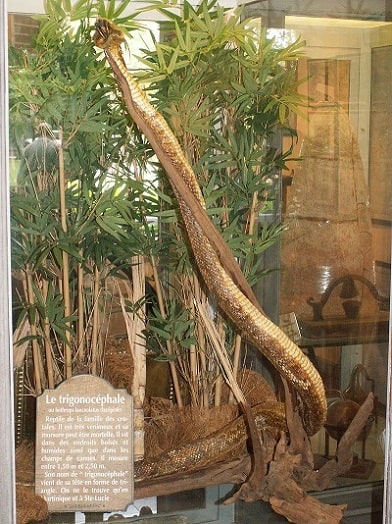
Martinique is a Caribbean island, located in the heart of the Lesser Antilles, hundreds of miles north of Venezuela. It’s a tropical paradise which is nevertheless extremely densely populated, with an estimated population of 340,000 people.
Rather than an independent nation, this is a French overseas territory, and has been ever since 1815, when the Napoleonic Wars ended, and the British handed it back as part of the peace treaty. Martinique was also the first Caribbean island to grow coffee, in addition to the usual sugar plantations. In 1848, it became the first French overseas territory to abolish slavery. The plantation workers were now free, but the island was hardly safe. One menace still remained: the Martinique lancehead, AKA Bothrops lanceolatus.
The Martinique lancehead is the sole venomous snake found on Martinique, and one of just 3 Bothrops pitvipers to live in the Caribbean, out of 45-50 worldwide. The vast majority of this deadly group live in South America, whether it’s jararacas or painted lanceheads, yet the Martinique lancehead has somehow ended up stranded on one island.
The Martinique lancehead is a particularly long species, averaging at 1.5-2 metres. They have classical murky viper colours, and are recognisable by a dark stripe beginning at each eye and extending backwards. This species is more than capable of killing a human being, and survivors can be left with life-changing injuries.
| 2 | May trigger heart attacks |
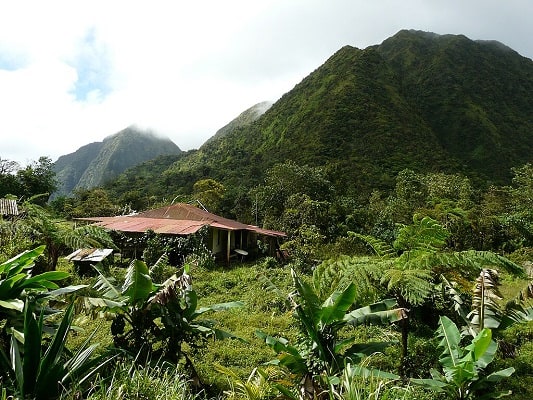
Bothrops lanceolatus has a unique venom for pitvipers in the Americas. It only causes moderate haemorrhaging, yet leads to severe thrombosis in the arteries. This happens in 20-40% cases, and is sometimes severe enough to trigger a heart attack.
A recent case happened to a 74 year old man who was bitten on the arm while gardening. He applied a local remedy instead of visiting the hospital, and was found unconscious two days later by his family. He received antivenom at the hospital, but failed to revive. A brain scan using magnetic resonance revealed multiple strokes, while an electrocardiogram revealed that the man had suffered a heart attack. The man eventually developed full blown heart failure and died 6 days later.
Bothrops lanceolatus is very rare for this ability to cause heart attacks, as well as thrombosis (deep vein clotting). For example, the vast majority of rattlesnakes cause strong haemorrhaging, but no thrombosis whatsoever. This species isn’t shy, and will pounce if it feels slightly threatened.
| 3 | High fatality rates |
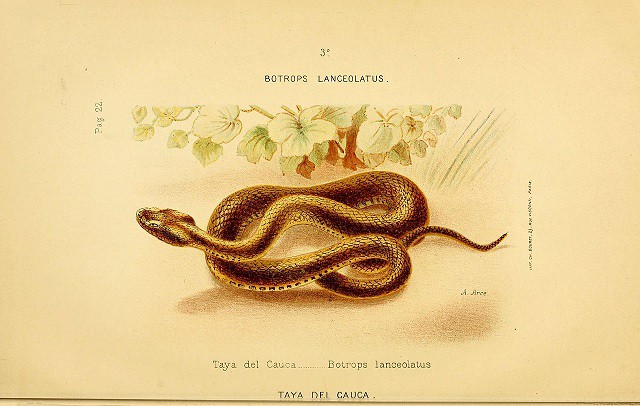
The Martinique lancehead unleashes severe inflammation, a large chunk of which comes not from the venom itself, but the body’s immune system response. Martinique suffers an estimated 20-30 snakebites per year, which isn’t much for a tropical equatorial paradise. However, the Martinique lancehead is the sole venomous species, and a particularly nasty one. Up to 25% of victims die or experience life-changing injuries. These include amputation of the affected limb, or paralysis from stroke brought on by deep vein thrombosis.
Martinique lanceheads have a supernatural reputation among locals. They’re used in the wicked arts of black magic, in “Kimbois”, in rituals such as bewitching potions. Its fangs supposedly have the power to poison crops, and its strength is enough to coil around a vehicle. There’s also reports from French explorers of a Martinique lancehead sucking on the breasts of a native woman.
Martinique lanceheads also have weaknesses compared to other pitviper venoms. They only have minimal levels of hyaluronidase enzymes, compared to the jararaca of Brazil, which has nearly 6 times more. Hyaluronidase dissolves hyaluronic acid (a staple of beauty creams) in the skin, allowing venom components to diffuse into the bloodstream faster.
| 4 | But antivenom is available |
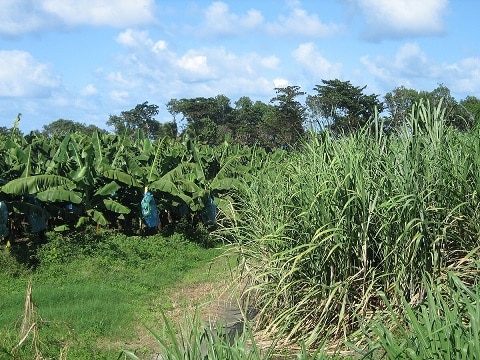
If you’re ever visiting Martinique for sun and sand, then remember that the resident pitviper is no joke. It’s not a paper tiger, and not a sheep in wolf’s clothing. Beware! There’s better news though. An antivenom was developed in 1991, specific to the Martinique lancehead species. This is made from horses, by collecting the immune system antibodies generated after venom injection.
This antivenom has been proven to vastly reduce fatalities from Bothrops lanceolatus, though it must be injected less than 6 hours post bite to have the strongest effect. The longer the delay, the more time a blood clot has to form. The antivenom is called Bothrofav®, and manufacted in Lyon, France. According to this 2019 study, “Bothrofav® immunocaptured all the major protein components” in Martinique lancehead venom. A 2018 study was just as positive, preventing haemorrhaging, swelling, proteolytic and myotoxic dangers.
Even an antivenom from Costa Rica made from different pitviper species neutralised 80% of Bothrops lanceolatus’s toxins. Martinique is believed to have first been occupied by the Arawak people in 130AD. Only now, 1900 years later, is there a safety buffer against the resident pitviper.
| 5 | Swells to large sizes |
The Martinique lancehead reaches a maximum of 200cm, which is longer than almost all Bothrops species in South America, except the fer-de-lance and a handful of others.
Females of the Martinique lancehead are particularly huge. They have a thicker body and a bulkier head, although their tail is slightly thinner than males. Because of their bulk, Martinique lanceheads can give birth in vast numbers of 60 snakes, or 70 if rumours are to be believed. Like most pitvipers, they lay live young which hatch in embryonic sacs within their bodies. These babies are independent from birth – there’s no need for their mothers to teach them like a bear.
Martinique lanceheads have a golden yellow belly, with a brown-upon-browner body. One recognisable sign is a thick brown stripe beginning behind the eye, and becoming steadily wider as it travels backwards. Their pupils are menacing vertical slits, and the eye’s colour is a parched, crusty yellow. Martinique lanceheads have a clean pink tongue, a whitish inside of the mouth, and brutally backwards curving fangs.
| 6 | The 20 dollar bounty |
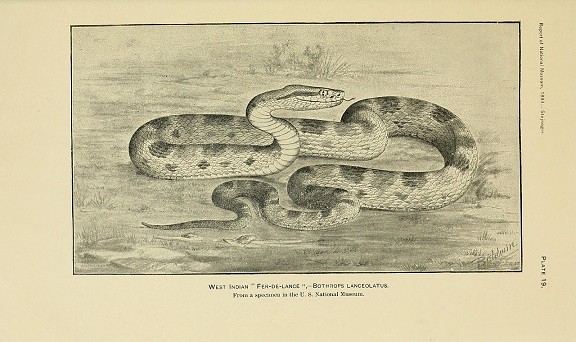
Martinique lanceheads aren’t teetering into extinction, but their numbers have plummeted in recent decades. It’s all down to a government sponsored extermination program. In 1970, a reward of 20USD was promised to anyone who brought in a dead Martinique lancehead.
A craze ensured, and in the first year alone, 12,000 lanceheads were killed. Everyone went for the easiest option – the lancehead in a banana field, in their back garden, in thickets next to a dirt path, etc. Eventually it was slim pickings, and by 2002, the year the bounty was cancelled, only 386 Martinique lanceheads were killed. Over the bounty’s operation, the numbers of snakes killed declined by 97%.
However, the urbanisation of Martinique is also a problem. This is a densely populated country, and the lancehead’s potential habitat has now fallen to below 50% of the island. Even without the bounty, its menacing appearance means that villagers automatically reach for their shovel, sometime pursuing it into the woods to banish the problem once and for all.
| 7 | Habitat: loves neglected farmland |
No study has been conducted on the Martinique lancehead’s diet, but every anecdotal report says that they love the taste of black rats (an invasive species on Martinique), and will go to the ends of the Earth to find them. Consequently, Martinique lanceheads are particularly common in crop fields. Poorly managed crop fields overgrown with thickets and weeds are their top spot. Wandering into an old abandoned banana plantation for a dare is a very poor idea on Martinique, as there’s nowhere Bothrops lanceolatus loves more.
Plantations generally are a top place; banana, pineapples, sugar-cane. This brings them into particular contact with farmers, who were once their biggest demographic of victims. In the last two decades, farming practises have changed in Martinique, with more controlled burnings to kill off weeds. These tear a path through the snakes within, reducing their numbers by accident.
Combined with antivenom, this means that Martinique is safer from this heart-stopping snake than it has ever been. But other places Bothrops lanceolatus lurks include gardens and sparse woodlands, where they hide in burrows, hollow trees and bushes. It’s very rare for them to appear in heavily urbanised areas (unlike the sewer-surfing reticulated python).
| 8 | Neighbour: St Lucia Lancehead |
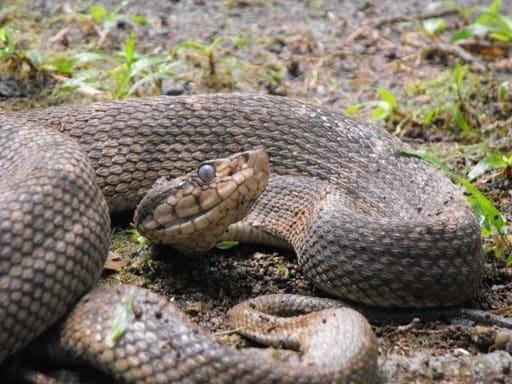
The Caribbean only has three Bothrops pitvipers. There’s the common lancehead, found across northern Brazil, which also resides on Trinidad. The third is the St Lucia lancehead (Bothrops caribbaeus), which lives only on its namesake island. B. carribaeus is found in coastal and lowland areas of St Lucia, at altitudes of 200 metres or lower. It lurks under rock piles and piles of coconut husks, and climbs occasionally, mostly sticking to the ground.
Like the Martinique lancehead, it’s one of the largest of the 48 member Bothrops family, regularly exceeding 1.3 metres. A difference is a slenderer snout, and a lighter body colour. St Lucia lanceheads have an olive body, with brown markings of varying size, sometimes invisible. Their belly is whitish to yellowish. Meanwhile, Martinique lanceheads are more consistently brown.
The St Lucia lancehead is the only venomous snake on its island, just as Bothrops lanceolatus is the only on Martinique. This species has also suffered from fear. Constant killing means that they’re now restricted to just 40% of their original territory. According to a 2008 study, its venom is largely similar to its cousin, with haemorrhaging, swelling and proteolytic qualities. Yet there were individual toxins not found in the Martinique lancehead, such as disintegrins, which disrupt blood clotting by blocking platelet aggregation (one of many subtle avenues).
| 9 | Mysteries of the past |
It was long a mystery as to why 2 of the 48 Bothrops pitviper species ended up on Caribbean islands. Some theorised that they swam, and that even today, the corridor remained open. However, a 2002 study pinpointed that the Martinique lancehead and its cousin evolved from the common lancehead (Bothrops atrox), one of the most common venomous snakes in South America.
They estimated that this happened in two waves – one northwards to St Lucia, followed by a separate wave to Martinique millions of years later. The study determined that the St Lucia lanceheads diverged an estimated 5.2-8.9 million years ago. The Martinique lancehead meanwhile, diverged from the St Lucia lancehead 3.1-6.5 millions years ago. The snakes have been separated a very long time, in spite of some tiny distances between them.
Martinique and St Lucia are only separated by 51 miles, and it’s only 280 miles from Martinique to the Venezuela coast. The study also found that St Lucia and Martinique lanceheads have a genetic separation of 4.2%. These two in turn have a genetic distance of 5.9% from Bothrops atrox on the mainland.
| 10 | Introduced by warring tribes? |
Science has now clarified the exact path this species took to evolve. But in 1965, a much weirder theory was proposed: that aboriginal islanders brought them there as a primitive form of biological warfare.
A heart-stopping snake would work well against rival tribes, but there’s the small problem of transportation. You’d be more likely to get bitten yourself as you prepare to throw them like a spear. Clear plastic containers weren’t invented until the 20th century. Then there’s the long sea voyage – Aboriginals had the boat-making knowhow to set out and colonise new islands, but to return to South America simply to grab snakes for battle? It’s too far-fetched.
Specifically, the legend was that Indian Caribs introduced the snakes to gain control of islands from the native Arawaks, around the 11th century. The Caribs originated from Venezuela, and were supposedly much more ferocious warriors than the gentler Arawaks. But the snake warfare theory is probably slightly too far. The St Lucia lancehead has its own version: that the snakes were introduced by plantation owners, to prevent slaves from running away.
